Principles. The principles of urban combat are surprise, speed, and controlled violence of action. These principles do not change, regardless of ROE. The three principles of urban combat are each relative to one another; i.e., successful surprise allows increased speed, and controlled violence coupled with speed increases surprise.
•Surprise is one of the elements necessary for a successful assault at close range. The assault team achieves surprise by attacking at a time and location unexpected by the defender, using everything from surreptitious entry to hand grenades, silent ropes, and ladders to explosive or ballistic breaching intended to stun the occupants of a room.
•Speed can provide a measure of security to the clearing unit by allowing soldiers to use the first few seconds provided by surprise to their advantage. In urban combat, speed cannot be careless—it must be careful and deliberate. The only way to develop speed with the care and deliberateness that this type of combat requires is through realistic training.
•Controlled violence of action eliminates or neutralizes the enemy and decreases his chances of inflicting friendly casualties. It also maintains coordination and control of friendlies, thereby avoiding the fratricide issues that can be prevalent in a chaotic urban fight.
Fundamentals of Clearing Operations
The actions soldiers take while moving through and clearing a building include:
•Dominate the space. When moving down hallways and corridors, it is essential that the team covers all potential danger areas and spaces. Soldiers should constantly be looking for work.
•Dominate the room. Soldiers should occupy the points of domination that are within their area of responsibility and that will overwhelm the enemy and provide interlocking fields of fire in order to cover potential threats.
•Eliminate the threat. As quickly as possible, the team should eliminate the threat in the room. This can be accomplished by using verbal signals, hand signals, or lethal force. Positively identify the threat IAW ROE and look at the hands to properly identify the immediate threat—threatening actions identify potential threats.
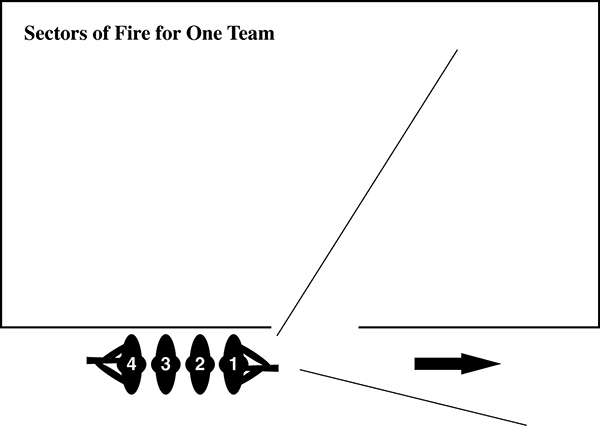
•Control the situation. Obtain control of the situation in the initial few moments. Loss of control or lack of control will result in a lack of momentum and an increase in the likelihood of confrontation.
Clearing Techniques
Methods of movement, firing techniques, weapon positioning, and reflexive shooting are fundamentals used in urban combat. Special clearing techniques may be required when highly restrictive ROE are in effect. The enemy situation may require that the units clear only a few selected buildings methodically to accomplish their mission rather than using firepower to suppress and neutralize buildings in the objective area. On the other hand, a robust ROE may favor the use of overwhelming firepower, in which case units should employ direct and indirect fires, demolitions, and fragmentation or concussion grenades as necessary to assist in clearing an objective defended by an alert and determined force without noncombatants.
Enter Building and Clear Room Drill
The fundamentals of surprise, speed and violence of action are of particular importance in CQB. Leaders must take care that fratricide or “blue on blue” incidents do not happen. Friendly fire incidents are avoided only through constant coordination and knowledge of where assets are in the battlespace. Avoid splitting up forces inside buildings and observe vigilant security in order to not fall victim to the complex geometry of rooms and hallways.
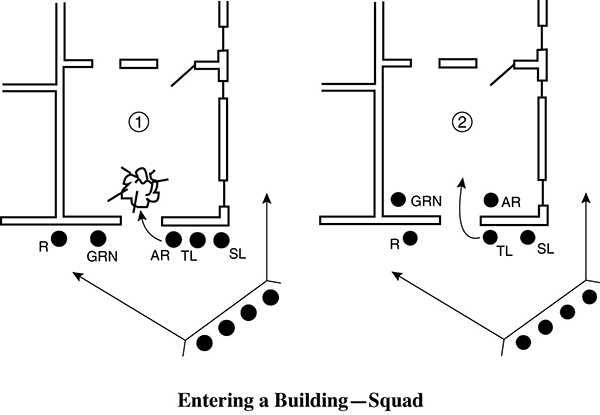
Step 1. The fire team initiating contact establishes a base of fire and suppresses the enemy in and around the building.
Step 2. The squad leader determines whether he can maneuver by identifying the building and any obstacles, the size of the enemy force engaging the squad, an entry point, and a covered and concealed route to the entry point.
Step 3. The squad leader directs the fire team in contact to support the entry of the other fire team. He also designates the entry point. The platoon and squad shift direct fires and continue to suppress the enemy in adjacent positions and to isolate the building. Indirect fires are lifted or shifted, as necessary.
Step 4. The squad leader and assaulting fire team approach the building and position themselves at either side of the entry point. (Doors and windows should be avoided because they will normally be covered by enemy soldiers inside the building.)
Step 5. The lead soldier of the assaulting fire team cooks off the grenade(s) (two seconds maximum); shouts, “Frag out” if element of surprise is lost; and then throws the grenade(s) into the building or room. The type of grenade used is dependent on the rules of engagement (ROE):
•METT-TC factors and types of construction materials used in the objective building influence whether flash bang, concussion, or fragmentation grenades can be used in assaulting an urban objective.
•Soldiers should engage upper-level openings with grenades (by hand or launcher) before entering to eliminate enemy who might be near the entrance.
Step 6. After the grenade detonates, an element of up to four soldiers moves to the entrance. Clearing begins as soon as the first soldier can see into the building (the soldier does not have to be physically in the room to engage the enemy within). The team enters the building, each in opposite directions from the soldier in front of him. Clearing of the room should be taking place the moment a soldier can see into the room and up to the point the unit reaches its point of domination. Each soldier will position himself to the left or right of the entrance, up against the wall. The entry team engages all identified enemy positions with rapid, well-aimed fire and then scans the room.
Note: It is important to understand that the securing of the room takes place as the soldiers are moving and does not wait for them to reach points of domination.
The rest of the team provides immediate security outside the building. The size, shape, adjacent space, and angles of the room cause the entry team soldiers to adjust their positions after the initial engagement.
Speaking is kept to a minimum to limit confusion.
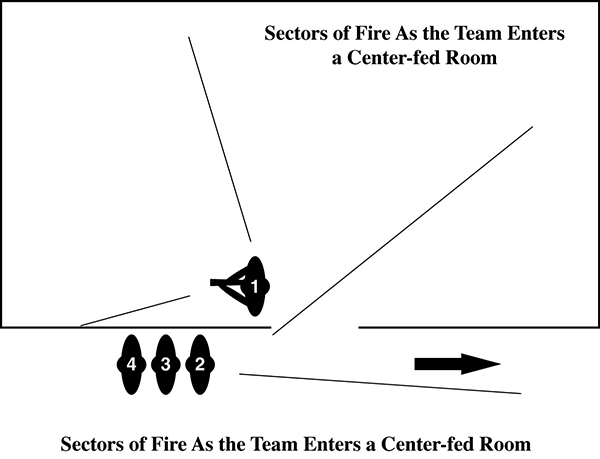
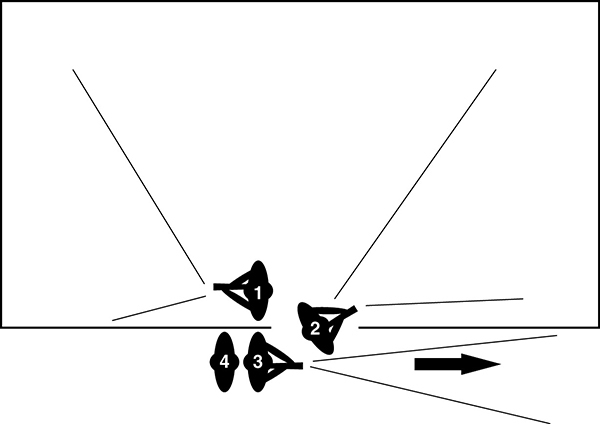
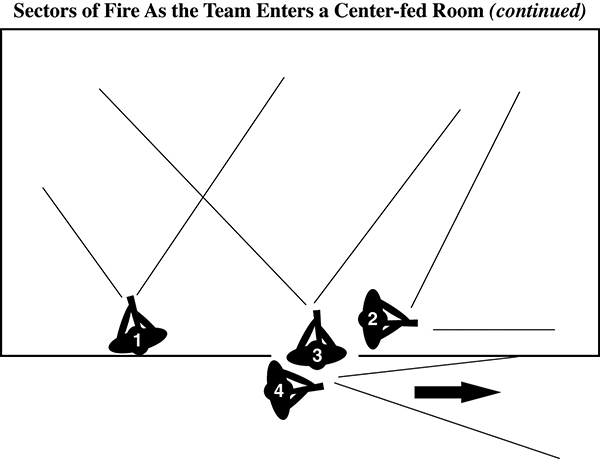
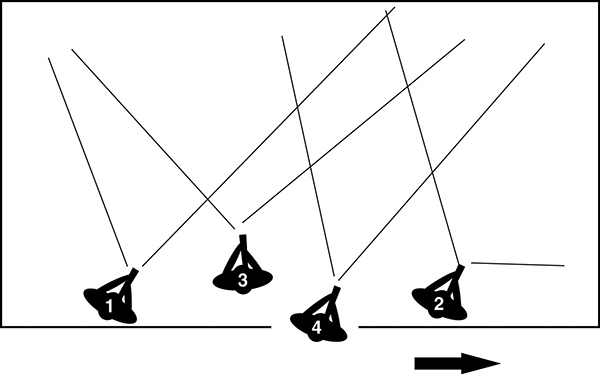

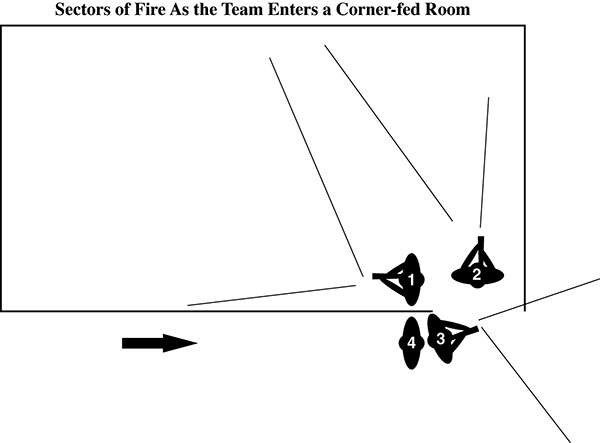
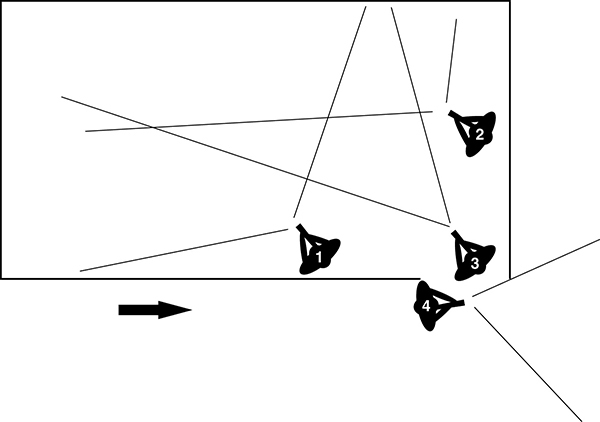
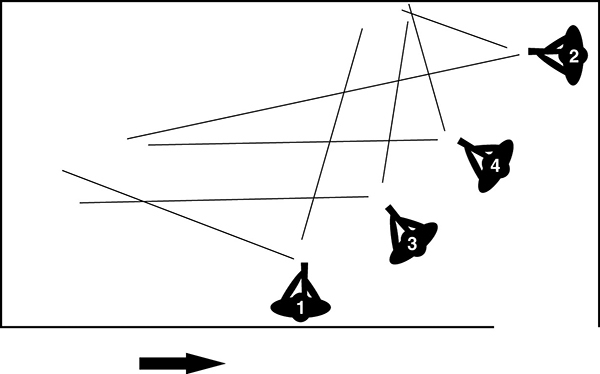
Step 7. The second team then moves into the room and falls in with the initial team or flows through the initial team to the immediate adjoining threat in the room (adjacent rooms, hallways, intersections, etc.) The clearing procedures continue on in the same manner.